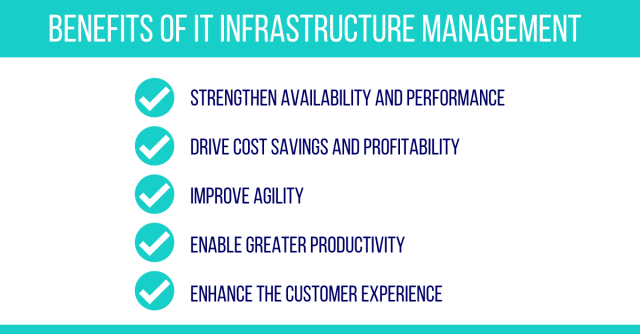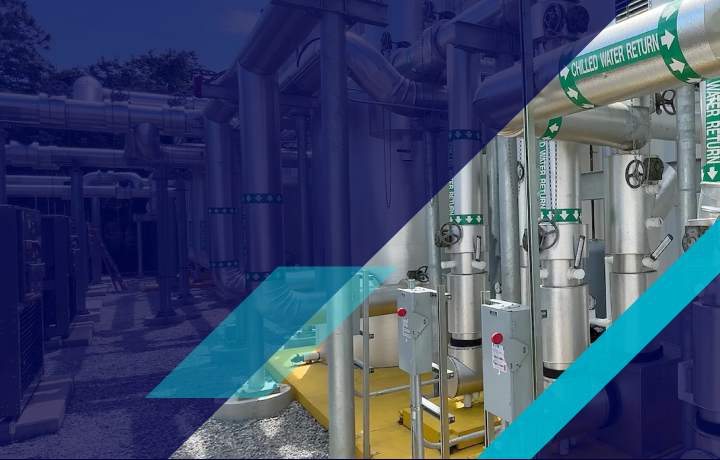What is IT infrastructure management?
IT infrastructure management is the backbone of successful business operations in an increasingly digital world, as it ensures the availability and performance of the IT environment.

To remain competitive, organizations must adapt their IT systems to support evolving customer requirements, innovative technologies, and industry expectations. This requires organizations to deploy and manage modern IT solutions effectively and consistently. Without appropriate infrastructure management processes, the reliability of the IT environment and the business’s ability to serve its customers can falter.
Definition of IT infrastructure management
IT infrastructure management involves the oversight of both physical and virtualized resources as well as the policies and procedures that ensure IT systems, the network, and data storage operate properly. These management functions encompass the design, implementation, ongoing management, and decommissioning of all assets and practices, including system maintenance, employee and vendor training, physical and logical security, data storage technologies, and everything in between.
IT infrastructure management components
Given the broad scope of IT infrastructure systems management, it can be helpful to break down responsibilities into five components.
Hardware management
The hardware component includes physical technology such as servers, generators, CRAHs, UPSs, and personal computers. IT teams must perform regular maintenance and updates on this equipment, monitor hardware performance, troubleshoot issues, configure systems, and manage refresh cycles to optimize performance and availability. Organizations may also need to manage the integration of legacy systems into new deployments to avoid silos.
Systems management
Organizations also need to ensure software applications such as customer relationship management (CRM) systems, enterprise resource planning (ERP) programs, content management solutions, business intelligence suites, and productivity applications remain online and perform appropriately so internal and external customers can access the necessary resources. The software component also includes the operating system that integrates and supports physical system components and the organizations’ business applications.
Network management
Network management addresses the devices and actions that enable employees, customers, and partners to access data and applications and communicate with the organization. Network management elements include routers, switches, firewalls, virtual network servers and software, and telephony equipment. IT personnel are responsible for configuring network devices, installing firewalls, performing regular maintenance, and consistently monitoring the network to identify and troubleshoot connectivity issues.
Data storage management
To ensure employees have access to the data they need when they need it, organizations must provision the necessary storage space and manage data storage technology, the underlying software, and backup and recovery policies. These practices ensure that users can retrieve data quickly and securely. Organizations must also determine whether to store data onsite, with a third-party provider, or in the cloud.
Security
The security component encompasses everything needed to protect the hardware, software, network, and storage infrastructures. This involves implementing and managing building access, login processes, configuration management, anti-virus software, firewalls, file encryption, managed detection and response (MDR) solutions, and data replication to improve an organization's security posture.
Why IT infrastructure management is important for business
Businesses have too much on the line for their IT environments to falter. Proactive IT infrastructure management practices ensure the uptime, performance, and security of business systems and data by identifying vulnerabilities and heading off issues before they can impact operations and the customer experience. The oversight and visibility offered by consistently delivered management practices also help organizations align their IT strategies with business priorities to drive competitive edges. It can also help streamline procedures to improve agility and efficiency, avoid duplicated efforts, uphold IT compliance, control IT expenses, and enhance productivity. This is particularly relevant for organizations facing new corporate objectives, digital IT transformations, mergers or acquisitions, and other changes.
Benefits of IT infrastructure management
When properly managed, IT infrastructure can deliver multiple benefits to organizations.
Strengthen availability and performance
While outages and service disruptions are inherent in digital operations, active monitoring, regular maintenance, and other management tasks can help limit interruptions and speed reaction time to promote business continuity.
Drive cost savings and profitability
Businesses are always looking for opportunities to save money. By proactively managing the components of IT infrastructure, organizations can minimize costly downtime, reported as more than $300,000 per hour by 91% of organizations in a 2021 survey. The visibility offered by effective management enables critical insight into organizations’ assets, practices, and protocols to improve capacity planning. This ensures organizations do not overspend on unnecessary resources or trigger downtime or performance issues with insufficient resources. Additionally, a reliable online presence ensures that customers can purchase products to generate revenue.
Improve agility
Aligning the IT environment with the business strategy and objectives and integrating automation helps organizations improve agility. Automation can tackle routine tasks and ease capacity planning, allowing IT teams to dedicate more time to other business-driven initiatives. The improved understanding of the environment also enables more rapid responses to issues and new demands. Integrating cloud-based deployments and management tools can also strengthen agility and improve efficiency. There is more to Cloud IT Infrastructure than you would think.
Enable greater productivity
Interruptions and underperforming applications can diminish productivity. An infrastructure management team promotes more reliable, high-performing systems so employees remain online and working efficiently.
Enhance the customer experience
Delivering an unmatched customer experience is a critical differentiator for every business. Organizations with effective IT systems ensure customers can access their websites, interact with their teams, and procure merchandise easily. Delays in attaining required services can downgrade the customer experience, damaging the organization’s reputation and potentially resulting in customer churn.
Why IT infrastructures need to be managed
IT infrastructure management is complex, with many individual yet interconnected pieces that must work together seamlessly to promote a secure, reliable, high-performing environment. Without the necessary commitment, organizations can expose themselves to a myriad of business-impacting issues that can threaten their operations, security, and bottom line. IT infrastructure management helps ensure the IT environment can continue to drive business value.
Support a rapidly changing environment
Business needs can change quickly, and the IT environment must be able to flex and scale to address these evolving requirements. IT infrastructure management provides an awareness that allows organizations to scale IT resources, including servers, power, bandwidth, and storage, to support future growth without overspending. For organizations that are managing multiple independent IT environments because of a merger or acquisition, this insight can help consolidate the infrastructures and eliminate redundant efforts and costs.
Address outdated systems
Technology evolves quickly, and keeping up to date can be challenging. Dedicated efforts to manage the infrastructure can help organizations track and monitor IT assets so they can replace aging or underperforming technology to boost operations. Timely hardware and software upgrades can also foster efficiency and drive business capabilities.
Recognize network and connectivity issues
In a digital business landscape, connectivity is king. Without a skilled eye consistently monitoring network performance and managing network devices, interconnections can fail. IT infrastructure management ensures network devices operate as needed and sufficient bandwidth is available to support data delivery.
Keep pace with mounting data
Managing the rapid surge of data is an ongoing challenge for organizations. In 2023, data creation is projected to grow 24% over the previous year. Through IT management practices, organizations can ensure they have sufficient data storage space and effective data management practices to support this growth and minimize the risk of data loss.
Ensure security
Robust security is a must for every element of every IT environment. Proper management can help ensure that the security strategy can safeguard systems, data, and the network. This is especially crucial for organizations with sensitive data and more stringent compliance obligations. Organizations can incur unnecessary fines, lose data, and risk customer trust without the appropriate protections.
IT infrastructure management best practices
To ensure a high-performing IT infrastructure, organizations should employ IT infrastructure management best practices.
Collecting information
Effective management begins with a discovery process in which organizations gather information on their IT systems, applications, and the processes and practices in place to maintain, service, and secure these resources. This data helps organizations build a comprehensive IT management strategy and ensure that no resources or processes are overlooked.
Establish and implement management standards
Using the knowledge gained in the discovery process, organizations should devise IT administration standards that meet their unique needs to ensure the appropriate deployment and use of IT infrastructure. This can include setting security protocols, configuring systems, designing training, determining maintenance processes and schedules for operating system platforms, and developing data management practices. After establishing these standards, organizations must ensure they are effectively and consistently implemented and enforced.
Monitor the environment and adapt the strategy
Ongoing monitoring of the environment and critical practices, using security and operations analysts as well as key metrics—such as downtime frequency, restoration speed, storage capacity, utilization, and network performance—can help organizations assess the efficacy of the management strategy and adapt practices to improve their effectiveness. Continually monitoring the IT environment also enables organizations to react quickly to system and network issues to keep systems functioning smoothly.
Document everything
Documenting the infrastructure management strategy, including individual assets, is essential. This information provides a playbook for the IT team, ensuring everyone is on the same page and understands the expectations. It also can help introduce new IT hires to the environment, operational expectations, and management plan. All performed maintenance, performance metrics, and security and availability issues should also be logged to track operational effectiveness and help build a better management strategy.
Flexential: A partner in IT infrastructure management
Managing IT infrastructure in today’s rapidly changing digital landscape is complex, and most organizations can benefit from a knowledgeable partner that can offer managed IT services. Flexential enables organizations to leverage leading-edge technologies, best practices, and data center expertise to handle everyday business issues such as growth, performance, availability, and security while achieving the agility to adapt their IT strategies to address evolving business needs quickly. According to a Total Economic Impact™ study by Forrester Consulting, these capabilities contributed to a 48% return on investment (ROI).
As a strategic infrastructure partner, Flexential offers integrated, managed infrastructure services that help organizations simplify infrastructure management. Through the FlexAnywhere® Platform—a highly connected and scalable platform with a full suite of colocation, interconnection, cloud, and managed and professional services—customers have access to the robust, secure data center services needed to build powerful hybrid IT environments that support business objectives.
Offering a series of managed services—including infrastructure managers, managed IT security services, and managed network services—Flexential allows organizations to offload data center infrastructure management to certified experts that follow regimented maintenance and refresh schedules to ensure the availability, performance, and security of the environment. With Flexential managing the data center, organizations’ internal teams can focus on the core business. Organizations can also leverage Flexential certified professionals to support their collocated servers and management processes, including building, managing, and maintaining their IT environments and supporting compliance obligations.
As organizations continue to rely on technology to operate their businesses and achieve competitive advantages, the performance and reliability of the IT environment will become increasingly important, making the management of the infrastructure vital. Organizations can bolster uptime and performance through effective management while better aligning the IT strategy with corporate priorities to strengthen business capabilities and drive added value.
Ready to leverage Flexential to support your IT infrastructure? Schedule a consultation today.







